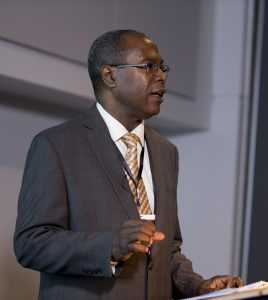What teaching and learning strategies do you use to differentiate a curriculum?
Jacob: A curriculum includes context, what is learned and what is taught; the delivery method, which is the teaching-learning method; forms of assessment such as course tests or examination; resources utilized in supporting the teaching process. To be effective, a trainer needs to have a repertoire of teaching and learning strategies to differentiate a curriculum. I endeavor to have a command of the laws of learning, such as:
- The law of exercise: Things most often repeated are best remembered
- The law of effect: Learning is strengthened when accompanied by a pleasant or satisfying feeling and weakened when associated with an unpleasant feeling
- The law of readiness: A person learns best when they are ready to learn, and will not learn much if they see no reason for learning
Fortified with knowledge of how individuals learn, I use various strategies to achieve the desired outcome, for example:
- Lecture
- Guided discussions as the facilitator
- Exercises
- Roleplay
- Participant discovery
Of absolute importance is the mastery of the curriculum content being taught by the trainer, which includes possession of the requisite knowledge and experience. Equally important is the ability to differentiate between learners, their learning styles, and preferences. Individuals differ, therefore, a flexible approach is necessary, as well as the commitment to ensure that no one is left behind or feels disconnected, discouraged or disenchanted.
Having a toolkit ready and the willingness to be flexible when using it, is a key requirement to achieve excellence. Since training programmes differ, it is vitally necessary to be able to match the approach based on each course. Often the situation dictates which tools from the kit are applicable. If one has a predetermined notion and is unwilling to be pragmatic, participants will end up being dissatisfied, the organization will lose its investment, and ultimately it will reflect poorly on the developer of the training materials.

What do you think are the most important attributes of a good trainer?
Jacob:The most important attributes of a trainer are competence, the possession of knowledge, skills, and appropriate behaviours; passion, enthusiasm and love of imparting knowledge; empathy, meaning the ability to understand participants’ issues; leadership, meaning the ability to effectively influence learners to work towards achieving the goals of the training session.
Knowledge of the subject matter fosters confidence in the trainer and gains the respect of participants from the outset. It enables the trainer to field questions easily and therefore enhances the learning process. Appropriate behaviors include respect for each participant and the ability to create a sense of emotional safety, so that participants feel accepted and valued, regardless of differences. In other words, being able to deal with diversity.
Passion is contagious. It is necessary that the trainer displays enthusiasm and makes the subject exciting, even if it has the potential to be boring. Although participants are paying for the course, it is the responsibility of the trainer to create a motivating atmosphere.
Empathy undoubtedly fosters the learning process. The effective trainer seeks to find common ground with participants from the outset. Throughout the session, with roving and watchful eyes, the trainer must spot participants who may not understand, appear to be shy of asking questions or who have that puzzled look that will simply not go away. Essentially this attribute will ensure that no one is left behind.
The trainer is a leader; as such he/she is required to influence learners with multiple goals, sometimes not necessarily aligned with the goals of the training session. Getting buy-in, as early as possible, in the training is of paramount importance. The trainer needs to cultivate leadership styles that deliver results. To do this, it is recommended that different styles be practiced so that if any are needed they can be utilized. This is referred to as the contingency or situational leadership model since it calls for the best-fit approach depending on the situation.
What would you do to help students understand the topic better?
Jacob: The understanding of the students’ goals and expectations for the training is indispensable. Having established these, it is vital to know what the student already knows. Having knowledge of human behaviors and individual differences give the advantage of tailoring the right methodology to facilitate learning. There are different instructional tools, the use of appropriate language, illustrations, experience sharing, lecturing, etc.
Pitching the material being taught at a level that the students can readily understand is vital. This is done through an audience analysis, which is best to be done early in the engagement. The ice-breaking period where the students give their expectations and goals for the training is a good point to listen and gain insights by noting their language and prior knowledge. The use of questioning and illustrations, the creation of word pictures, is also effective in fostering understanding.
Give us an example of a successful training program you taught. What made it so successful?
Jacob: I have had tremendous success in conducting various PECB training programs. I have hosted several ISO 9001 Lead Auditor and ISO 31000 Lead Risk Manager sessions in which all participants were successful. Most recently, a class of 7 participants in the ISO 22000 Lead Implementer, all but one individual passed the examination (see pictures of a session). This participant conceded that he was hampered by his lack of industrial experience and inability to put the material in context.
I believe a combination of factors is responsible for my success as a trainer. Early establishment of rapport with students, effectively engaging them in participation through teamwork, the application of the laws of learning, a revision of materials covered the previous day, and the use of motivational techniques, have proven to be powerful success factors.
Getting students to develop the can-do attitude by driving out fear of failure has worked remarkably well. Often students are intimidated by the sheer volume of materials to be covered. Reassuring them of their ability to master the materials through diligent study, participation in exercises, speaking up in classes, have all worked to build confidence. In addition, reserving time to “walk-through” the training manual, emphasizing the body of knowledge specified for the examination has been a great way to build confidence. Getting students to read the notes to slides aloud not only facilitates participation but keeps them engaged and enables memory.
Of great value is the organization of the PECB training manuals. Invariably they are student-friendly and designed to pace the learner, as well as, force the application of key teaching and learning strategies.

Not every student learns at the same rate or at the same level. How would you ensure everyone in your program develops their skills?
Jacob: An effective trainer caters to all participants; no one must be left behind. Each participant pays and, therefore, deserves value for their money and to be shown respect regardless of diversity in the knowledge base or other factors.
Breakout groups, with the individual differences in mind, ensure that stronger individuals are mixed with those who are less capable, which helps those with less knowledge to develop. Therefore, during these sessions trainers should: ask questions geared at the level of the individuals which encourages them to speak up confidently and further participate; be open to questioning, regardless of whether they make sense; walk about during the breakout sessions and encourage everyone to participate. These are all techniques that work effectively. Another key strategy is to be open to individuals who may be struggling with concepts and need individual consultation. Encouraging them to speak privately during break periods demonstrates the commitment to customers (the learners), and provides a forum for resolution of thorny issues.
There are a variety of ways trainers, as we have seen, can stimulate students to participate in classroom activities. How do you engage students in a training course?
Jacob: I typically emphasize the benefits of the course and the value of certification as a key motivator, the old “what’s in it for me” concept. This is an easy sell, given the global trends in the value of certification versus qualifications in certain disciplines. I normally encourage participation in the session and get the class to agree to it as a ground rule. I build on that by introducing the concept of synergy, indicating that when participants share their knowledge, they grow and help others to grow.
Additionally, I stress on the cost of the course, pointing out the fact that their employer is investing a significant sum in having them in a class for 5 days, therefore, it is incumbent for them to make the most of the course so that they can show a return on investment for their sponsor.
What do you consider to be the key criteria for a training course to be effective?
Jacob: The key criteria for a training course to be effective include:
- Relevance and marketability of the course
- Competence of the trainer
- Preparedness or readiness of the participants
- Teaching and learning strategies (the curriculum)
- Opportunity for application of knowledge gained
What advice would you give to new trainers in enhancing their training dynamics?
Jacob:
- Keep learning; most persons would rather drink from a flowing stream than a stagnant pool
- Be passionate about what you do; enthusiasm is contagious
- Gain mastery of the body of knowledge, but also get experience; most participants want illustrations based on the trainer’s experience
- Be confident; if you don’t feel it, fake it. Your audience won’t know the difference and soon you will become natural at being confident and this will inspire your trainees
- Engage, engage, engage; you are not there just to take them through the training materials, but to facilitate a great and memorable learning experience.









